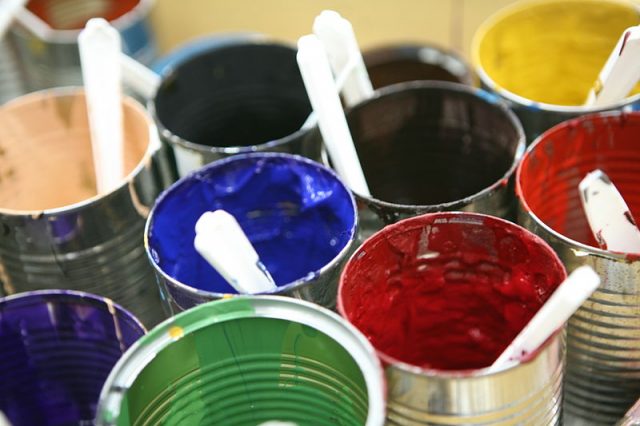By Emma Lloyd
There’s a huge amount of options available when it comes to selecting paint. Narrowing down the exact shade and colour is just the tip of the iceberg: you also need to decide between different levels of gloss and sheen, formulations for indoor or outdoor applications, and a stack of other criteria. But how can you know which paint is best for the environment, and for your health?
It helps to know what actually goes into a can of paint. It’s made from three basic ingredients: the pigment, the binder and the solvent. It can also contain additives such as biocides (which prevent bacteria or fungal growth, either in the can or on the painted surface). Each ingredient can have an impact on the environment and on human health during the lifecycle of the paint, from where the base ingredients are sourced, right down to the disposal of the end product.
If you’ve browsed the paint collection at your local hardware store lately, you may have noticed some varieties with ‘no VOC’ or ‘low VOC’ claims splashed across the tin. This refers to the solvent in the paint and whether it’s water-based or organic. Water-based paint solvent is always preferable because it’s harmless when it evaporates. Organic solvents, however, will release volatile organic compounds (VOCs) into the surrounding air.
VOCs are detrimental to indoor air quality. They can trigger allergies, asthma, headaches and other irritating symptoms as they readily vaporise into the surrounding air. Some VOCs can include formaldehyde and potentially carcinogenic (cancer-causing) substances – definitely not something you want to expose your family to! VOC levels in indoor environments rise dramatically immediately after you finish painting, and can continue seeping out of the walls for several years to come. That’s why it’s best to opt for a no-VOC paint whenever possible.

Pigment gives a paint its colour, opacity and provides a protective barrier in the paint. Titanium dioxide is widely used in the paint industry for this purpose and its manufacturing process can be environmentally harmful: it requires a lot of energy to produce, is a limited resource and results in unwanted air and water emissions.
The binder is what forms the film in a paint, helping it to adhere to the surface and influencing the resulting shine or flexibility. They can consist of synthetic or natural resins such as acrylics, polyurethanes, vinyl acrylics, melamine resins, epoxies or oils. Some binders cause a greater environmental impact than others. In particular, linoleic acid production (linseed oil) causes significantly more environmental damage to an ecosystem due to crop growth and agriculture.
The other components of paints can contain ingredients that are toxic to those producing the paint and those applying it. Many chemicals are used as biocides, and these are necessary. However, some can be carcinogens or cause mutations, so it’s important to avoid these. Some biocides can also release VOCs, even when you purchase a water-based paint, which is why no-VOC formulations are best.

How can you know the best paint to purchase to ensure better indoor air quality in your home? One simple step is to look out for any third party labels or accreditation on the product (one example is the ecolabel scheme run by Good Environmental Choice Australia), which shows that the manufacturer’s claims are genuine. There are many brands on the market to choose from that make environmentally-preferable and healthier paint products, and several which have taken the extra step of getting third party certification. Often they cost the same as their standard formulation alternatives and achieve the same level of quality for the end result.
For your next paint project, consider choosing a healthier and more environmentally-preferable product to coat your walls, ceilings and furniture. Your body (and your family) will thank you for it and it’s better for the planet as well.
Emma Lloyd is the communications officer for Good Environmental Choice Australia (GECA), which runs Australia’s only independent, not-for-profit ecolabelling program. GECA helps people choose products and services that are better for the environment.










